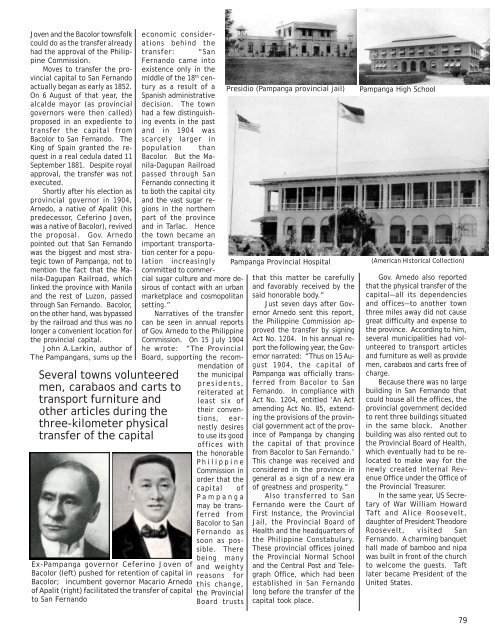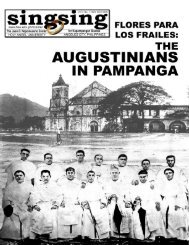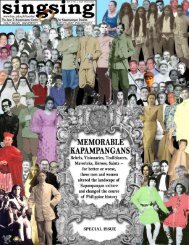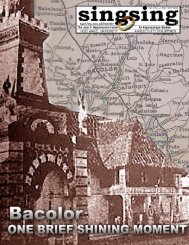Download PDF - Holy Angel University
Download PDF - Holy Angel University
Download PDF - Holy Angel University
You also want an ePaper? Increase the reach of your titles
YUMPU automatically turns print PDFs into web optimized ePapers that Google loves.
Joven and the Bacolor townsfolk<br />
could do as the transfer already<br />
had the approval of the Philippine<br />
Commission.<br />
Moves to transfer the provincial<br />
capital to San Fernando<br />
actually began as early as 1852.<br />
On 6 August of that year, the<br />
alcalde mayor (as provincial<br />
governors were then called)<br />
proposed in an expediente to<br />
transfer the capital from<br />
Bacolor to San Fernando. The<br />
King of Spain granted the request<br />
in a real cedula dated 11<br />
September 1881. Despite royal<br />
approval, the transfer was not<br />
executed.<br />
Shortly after his election as<br />
provincial governor in 1904,<br />
Arnedo, a native of Apalit (his<br />
predecessor, Ceferino Joven,<br />
was a native of Bacolor), revived<br />
the proposal. Gov. Arnedo<br />
pointed out that San Fernando<br />
was the biggest and most strategic<br />
town of Pampanga, not to<br />
mention the fact that the Manila-Dagupan<br />
Railroad, which<br />
linked the province with Manila<br />
and the rest of Luzon, passed<br />
through San Fernando. Bacolor,<br />
on the other hand, was bypassed<br />
by the railroad and thus was no<br />
longer a convenient location for<br />
the provincial capital.<br />
John A.Larkin, author of<br />
The Pampangans, sums up the<br />
Several towns volunteered<br />
men, carabaos and carts to<br />
transport furniture and<br />
other articles during the<br />
three-kilometer physical<br />
transfer of the capital<br />
economic considerations<br />
behind the<br />
transfer: “San<br />
Fernando came into<br />
existence only in the<br />
middle of the 18 th century<br />
as a result of a<br />
Spanish administrative<br />
decision. The town<br />
had a few distinguishing<br />
events in the past<br />
and in 1904 was<br />
scarcely larger in<br />
population than<br />
Bacolor. But the Manila-Dagupan<br />
Railroad<br />
passed through San<br />
Fernando connecting it<br />
to both the capital city<br />
and the vast sugar regions<br />
in the northern<br />
part of the province<br />
and in Tarlac. Hence<br />
the town became an<br />
important transportation<br />
center for a population<br />
increasingly<br />
committed to commercial<br />
sugar culture and more desirous<br />
of contact with an urban<br />
marketplace and cosmopolitan<br />
setting.”<br />
Narratives of the transfer<br />
can be seen in annual reports<br />
of Gov. Arnedo to the Philippine<br />
Commission. On 15 July 1904<br />
he wrote: “The Provincial<br />
Board, supporting the recommendation<br />
of<br />
Ex-Pampanga governor Ceferino Joven of<br />
Bacolor (left) pushed for retention of capital in<br />
Bacolor; incumbent governor Macario Arnedo<br />
of Apalit (right) facilitated the transfer of capital<br />
to San Fernando<br />
the municipal<br />
presidents,<br />
reiterated at<br />
least six of<br />
their conventions,earnestly<br />
desires<br />
to use its good<br />
offices with<br />
the honorable<br />
Philippine<br />
Commission in<br />
order that the<br />
capital of<br />
Pampanga<br />
may be transferred<br />
from<br />
Bacolor to San<br />
Fernando as<br />
soon as possible.<br />
There<br />
being many<br />
and weighty<br />
reasons for<br />
this change,<br />
the Provincial<br />
Board trusts<br />
Presidio (Pampanga provincial jail)<br />
Pampanga Provincial Hospital<br />
that this matter be carefully<br />
and favorably received by the<br />
said honorable body.”<br />
Just seven days after Governor<br />
Arnedo sent this report,<br />
the Philippine Commission approved<br />
the transfer by signing<br />
Act No. 1204. In his annual report<br />
the following year, the Governor<br />
narrated: “Thus on 15 August<br />
1904, the capital of<br />
Pampanga was officially transferred<br />
from Bacolor to San<br />
Fernando. In compliance with<br />
Act No. 1204, entitled ‘An Act<br />
amending Act No. 85, extending<br />
the provisions of the provincial<br />
government act of the province<br />
of Pampanga by changing<br />
the capital of that province<br />
from Bacolor to San Fernando.’<br />
This change was received and<br />
considered in the province in<br />
general as a sign of a new era<br />
of greatness and prosperity.”<br />
Also transferred to San<br />
Fernando were the Court of<br />
First Instance, the Provincial<br />
Jail, the Provincial Board of<br />
Health and the headquarters of<br />
the Philippine Constabulary.<br />
These provincial offices joined<br />
the Provincial Normal School<br />
and the Central Post and Telegraph<br />
Office, which had been<br />
established in San Fernando<br />
long before the transfer of the<br />
capital took place.<br />
Pampanga High School<br />
(American Historical Collection)<br />
Gov. Arnedo also reported<br />
that the physical transfer of the<br />
capital—all its dependencies<br />
and offices—to another town<br />
three miles away did not cause<br />
great difficulty and expense to<br />
the province. According to him,<br />
several municipalities had volunteered<br />
to transport articles<br />
and furniture as well as provide<br />
men, carabaos and carts free of<br />
charge.<br />
Because there was no large<br />
building in San Fernando that<br />
could house all the offices, the<br />
provincial government decided<br />
to rent three buildings situated<br />
in the same block. Another<br />
building was also rented out to<br />
the Provincial Board of Health,<br />
which eventually had to be relocated<br />
to make way for the<br />
newly created Internal Revenue<br />
Office under the Office of<br />
the Provincial Treasurer.<br />
In the same year, US Secretary<br />
of War William Howard<br />
Taft and Alice Roosevelt,<br />
daughter of President Theodore<br />
Roosevelt, visited San<br />
Fernando. A charming banquet<br />
hall made of bamboo and nipa<br />
was built in front of the church<br />
to welcome the guests. Taft<br />
later became President of the<br />
United States.<br />
79








